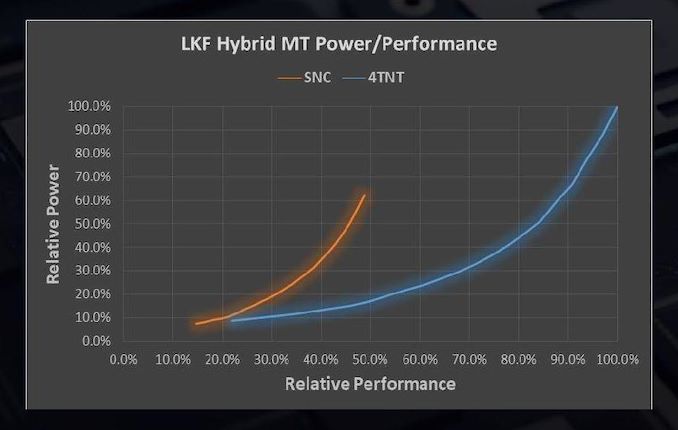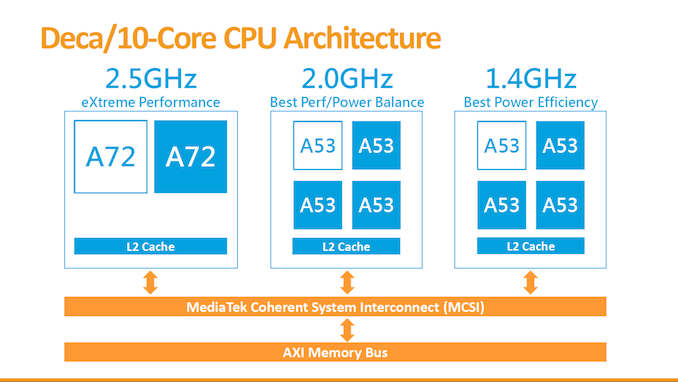The Intel Lakefield Deep Dive: Everything To Know About the First x86 Hybrid CPU
by Dr. Ian Cutress on July 2, 2020 9:00 AM ESTHow To Treat a 1+4 Hybrid CPU
At the top of the article, I explained that the reason for using two different types of processor core, one big on performance and the other big on efficiency, was that users could get the best of both worlds depending on if a workload could be run efficiently in the background, or needed the high performance for a user experience interaction. You may have caught onto the fact that I also stated that because Intel is using a 1+4 design, it actually makes more sense for multi-threaded workloads to run on the four Atom cores.
Using a similar power/performance graphs, the effect of having a 1+4 design is quite substantial. On the left is the single core power/performance graphs, but on the right is when we compare 1 Sunny Cove to all 4 Tremont cores working together.
Where the previous graph considered a 1+1 design, which is more relevant in those user experience scenarios listed above, on the right is the 1+4 design for when the user demands a heavier workload that might not be latency critical. Because there are four Atom cores, the blue line multiplies by four in both directions.
Now obviously the real world scenario is somewhere between the two, as it is possible to use only one, two, or three of the smaller cores at any given time. The CPU and the OS is expected to know this, so it can govern when workloads that can be split across multiple cores end up on either the big core or the small core.
In this graph from Intel, we have three distinct modes on which threads can operate.
- ‘Sunny Cove/SNC’ is for responsiveness and user experience threads,
- ‘Tremont/TNT Foreground’, for user related tasks that require multiple threads that the user is waiting on.
- ‘Tremont/TNT Background’, for non-user related tasks run in efficiency mode
Even though the example here is web browsing, it might be best to consider something a bit beefier, like video encoding.
If we run video encoding, because it is a user related task that requires multiple threads, it will run on the four Tremont cores (TNT FG). Anything that Windows wants to do alongside that gets scheduled as TNT BG. If we then open up the start menu, because that is a responsiveness task, that gets scheduled on the SNC core.
Is 1+4 the Correct Configuration?
Intel here has implemented a 1+4 core design, however in the smartphone space, things are seen a little differently. The most popular configuration, by far, is a 4+4 design, simply because a lot of smartphone code is written to take advantage of multiple foreground or multiple background threads. There are a number of cost-down designs that reduce die area and power by going for a 2+4 implementation. Everyone seems adamant that 4 is a good number for the smaller cores, partly because they are small and cheap to add, but because Arm’s quad-core implementation is a base unit for its IP.
The smartphone space in recent quarters has also evolved from a two tier system of cores. In some of the more leading edge designs, we now have three types of core: a big, a middle, and a small. Because of the tendency to stay with eight core designs, we now get 1+3+4 or 2+2+4 designs, powered by complex schedulers that manage where to put the threads for the best user experience, the best battery life, or somewhere in the middle. Mediatek has been famously dabbling in 10 core designs, going for a 2+4+4 approach.
One thing missing from all of these implementations is an SoC with one big core and four small cores. Smartphone vendors don’t seem to be interested in 1+4 silicon, and yet Intel has decided on it for Lakefield. This is borne out of decisions made on both sides.
From the smartphone perspective, when hybrid designs came about, the big cores just weren’t powerful enough on their own. In order to offer something more than simply basic, at least two cores were needed, but because of how Arm architected the big and little designs, it almost became standard to look into 4+4 implementations of big and small cores. It was only until this configuration was popularized over a couple of years, and Arm big cores got more powerful, that chip designs started looking at 2+4, or 1+3+4 designs.
On Intel’s side of the fence, the biggest problem it has is the size of the Sunny Cove core. By comparison, it’s really, really big. Because the graphics core is the same as Ice Lake and reuses its design, there simply isn’t enough room within the 82 mm2 compute die to add another core. Not only that, but there is a question of power. Sunny Cove wasn’t built for sub-1W operation, even in the Tremont design. We see big smartphone silicon pulling 4-5W when all eight cores are active – there is no way, based on our understanding of Intel’s designs, that we could see four (or even two) Sunny Cove cores being in the optimal performance per watt range while being that low. Intel’s Lakefield graphics, with 64 EUs, is running at only 500 MHz – a lot lower than the Ice Lake designs. Even if Intel moved that down to a 32 EU design to make space for another Sunny Cove core, I reckon that it would eat the power budget for breakfast and then some.
Intel has made the 1+4 design to act as a 0+4 design that sometimes has access to a higher performance mode. Whereas smartphone chips are designed for all eight cores to power on for sustained periods, Lakefield is built only for 0+4 sustained workloads. And that might ultimately be its downfall. This leads onto a deep discussion about Lakefield’s performance, and what we should expect from it.














221 Comments
View All Comments
extide - Thursday, July 2, 2020 - link
It's 22FFL, which is a derivative of the 14nm process.ProDigit - Friday, July 3, 2020 - link
All chip manufacturers make CPUs at variable lithography. Even AMD. When it says their Ryzens are built on a 7nm node, it means 7nm is the smallest, but other parts still use 10, 12, 14 or 22 nm.Ryzen 2000 CPUs had parts still running on 28nm.
FunBunny2 - Friday, July 3, 2020 - link
"other parts still use 10, 12, 14 or 22 nm. Ryzen 2000 CPUs had parts still running on 28nm."which raises a question, which I suppose is answered somewhere in the hardware engineering space: I suppose having multiple 'node' sizes on the same line is possible due to the fact that the native 'node' is way larger than, in this case, 7nm by multi-masking, and backing off on masks to print the larger 'node' segments. so, if we should ever get to some Xnm, say 7nm, as native resolution, would the machinations to print up, say 28nm, be more work than the current process of printing down?
bji - Thursday, July 2, 2020 - link
Very likely you meant 0.2 PICOjoules of energy consumed per bit, not 0.2 PETAjoules.JayNor - Thursday, July 2, 2020 - link
Someone from Intel mentioned that they have a chiplet version of their LTE modem that can go in the stacked design. I don't recall where the interview is, though...Deicidium369 - Thursday, July 2, 2020 - link
https://tech.hindustantimes.com/tech/news/intel-s-... makes mention of Lakefield and an LTE modem."chiplet" is a marketing term.
Ian Cutress - Monday, July 20, 2020 - link
We asked that with our interview with Ramune Nagisetty from Intel. They say they can do it, but it's not done here.brucethemoose - Thursday, July 2, 2020 - link
Theres potential for another Micron partnership here, as Intel needs custom stackable DRAM dies with TSVs that they can stick below a compute die. Going through the package and back up to memory with a long, narrow interface seems like a tremendous waste of power.And That 4-atom cluster takes up as much space as a AVX-less sunny cove die... a bunch of those would be interesting in a reticle size or EPYC-style Xeon. Cloud providers subdivide giant Xeons into smaller instances anyway, and I imagine that many customers would prefer 4 full cores for the same cost as a single hyperthreaded one. Thats more or less what AWS is pitching with their Graviton chips.
nandnandnand - Thursday, July 2, 2020 - link
Just imagine a 256-core Gracemont or later Atom CPU using chiplets. That could be great for servers.That's basically a return to Xeon Phi, except those cores were modified to do AVX-512.
brucethemoose - Thursday, July 2, 2020 - link
Indeed. In hindsight, Intel designed and pushed Phi towards the wrong market.